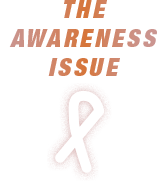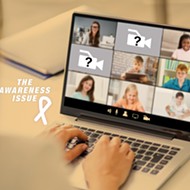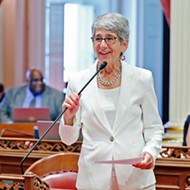Undetected: Reports of child abuse have decreased since the pandemic started, but that's not necessarily a good thing
By Kasey Bubnash[{
"name": "Ad - Medium Rectangle CC01 - 300x250",
"id": "AdMediumRectangleCC01300x250",
"class": "inlineCenter",
"insertPoint": "8",
"component": "2963441",
"requiredCountToDisplay": "12"
},{
"name": "Ad - Medium Rectangle LC01 - 300x250",
"id": "AdMediumRectangleCC01300x250",
"class": "inlineCenter",
"insertPoint": "18",
"component": "2963441",
"requiredCountToDisplay": "22"
},{
"name": "Ad - Medium Rectangle LC09 - 300x250",
"id": "AdMediumRectangleLC09300x250",
"class": "inlineCenter",
"insertPoint": "28",
"component": "3252660",
"requiredCountToDisplay": "32"
}]
When COVID-19 hit and local schools closed in mid-March, the San Luis Obispo County Department of Social Services almost immediately saw a decline in reports of suspected child abuse.
In March, calls to the county's child abuse reporting hotline were down by 25 percent compared to the same month in 2019, according to data collected by the SLO County Department of Social Services. April saw a 32 percent decline from the same month last year, and reports of suspected child abuse fell by 33 percent in May compared to the year before.
In normal times, that drop would be something to celebrate. But now, with school campuses closed and children away from their teachers, the sudden change is troubling to child welfare experts like Linda Belch, deputy director of SLO County Adult and Children's Services.
"We were all concerned about making sure that these kids didn't go unseen," Belch told New Times.
Like all professionals who are likely to come into contact with children, teachers and other public school employees are mandated by law to report suspected child abuse. Historically, school employees file such reports more often than any group in California. They usually see kids every day, Belch said, and are trained to spot the telltale signs of abuse or neglect—bruises, dirty clothes, unruly behavior.
So it's no surprise that when schools closed and teachers stopped seeing their students each day, reports of child abuse dropped throughout the state. From April through August, reports of suspected child abuse in California fell 28 percent compared to reports during the same months last year, according to data provided to EdSource by the California Department of Social Services.
Now, six months into the coronavirus pandemic, schools and child welfare professionals are still adjusting to distance learning and the ways in which it's changed how child abuse is reported.
In April, Belch said, SLO County Social Services put together a resource guide on spotting, reporting, and preventing child abuse and neglect during the pandemic. The guide largely focuses on signs of abuse that community members—grocery store clerks, food delivery workers, and neighbors—should watch for and simple ways to intervene if needed.
It's all about getting people who wouldn't normally think about reporting suspected abuse or neglect involved at a time when mandated reporters aren't as able to.
"I think some people are hesitant to call child welfare," Belch said. But, she said, "I think a lot of people have a really good instinct."
Asking kids simple questions like, "What did you have to eat for breakfast today?" or "What is your least favorite part of staying home from school?" can result in telling answers. When in doubt, Belch said, call and report your suspicions.
The county's end goal is always to keep a family together, and even just having Social Services check in with parents and caregivers can help to prevent abuse before it happens, Belch said. Sometimes getting a family connected with the right services, whether it be counseling or financial aid, makes all the difference.
This is a stressful time for everyone, Belch said, especially for parents of school-aged children. Whole families are stuck at home together all day long, and many parents are struggling with major financial hits while also trying to help their kids navigate virtual learning.
"It's unfortunately just a ripe situation for abuse to happen," Belch said.
Things appear to be steadily improving. In June, July, and August, SLO County Social Services had closer to normal numbers of reports of child abuse, holding out at around 10 percent less than usual.
But Belch said that fewer reports now are coming from school employees and more from law enforcement officers responding to calls for service, typically reports of domestic disputes and violence. That's unfortunate, Belch said, because it means something bad has already happened by the time Social Services gets involved with the children, and they'd like to be engaged with at-risk families a lot earlier.
Arroyo Grande High School Counselor Joanna Onato-Molina is one of the many local school employees working to increase engagement.
After the sudden transition to distance learning in the spring of last school year and the chaos that followed, Onato-Molina said counselors in the Lucia Mar Unified School District got together to brainstorm solutions to the problem of reporting abuse and neglect.
As a counselor, Onato-Molina said she often works with at-risk kids and their families, and she knows better than anyone that a lot of the homes her students are now staying in all day every day are not ideal for learning or living.
"Some parents are alcoholics," she said. "Some parents are abusive."
When kids are dealing with tough situations at home, it often shows—in their behavior, their grades, and in their appearance. But now teachers have fewer signals to watch for.
Although elementary school kids in the Lucia Mar district are encouraged to keep their cameras on during Google Meets, it's optional for kids in higher grades. A lot of students are embarrassed by where they live or are caring for younger siblings while trying to attend school themselves, Onato-Molina said, and educators can't and don't want to force students to show more of their private lives than they want to.
But that also means bruises and other signs of neglect go unseen.
There is, however, one glaring red flag signaling that kids aren't OK: "They're not showing up."
"When you don't have support at home," Onato-Molina said, "and you have a parent that works all day long, and you have a kid who was already at-risk, the one thing they love to do is just not do it."
So in some ways COVID-19 has actually made it easier for educators to spot the kids who have serious issues at home. Teachers send counselors lists of students who consistently miss class and assignments, and counselors check in with those students and their families and connect them with whatever resources they need.
It's the kids who fall somewhere in between that are difficult to identify from afar.
At the beginning of this school year, Lucia Mar launched a new program aimed at regularly checking in with and identifying the needs of students. Each Friday, students in elementary school go to "care groups," and junior high and high school students go to "advisory" classes, where they take a survey about how they're feeling about schoolwork, their mental health, and their home lives.
Teachers, counselors, and administrators look over the surveys, and students who divulge concerning information are checked in on. The process is one of the seemingly few bright spots of the pandemic, and has already provided schools with valuable information they wouldn't otherwise have. It's helped schools pick out the most at-risk students as intended, but it's also helped identify trending emotions and common problems.
"Right now," Onato-Molina said, "most of the concerns and most of what we're seeing is just students really struggling with not being able to be around their peers and not having that social interaction."
"Having this advisory is something we want to continue outside of COVID," she said, "because we've learned that it's a valuable tool for us." Δ
Staff Writer Kasey Bubnash can be reached at [email protected].
Latest in News
Comments (3)
Showing 1-3 of 3
Readers also liked…
-

Coast Unified teachers upset over new position's salary and qualifications
Oct 20, 2022 -

SLO police identify alleged driver who hit and killed couple
Dec 22, 2022 -

When the levee breaks: Oceano residents, county officials walk a tightrope of regulations to manage Arroyo Grande Creek, which some say led to the levee's failure in January
May 18, 2023














